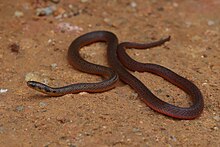
Boiga ceylonensis is a species of rear-fanged, mildly venomous, nocturnal, arboreal colubrid snake endemic to Sri Lanka.

Craspedocephalus trigonocephalus, the Sri Lankan pit viper, Ceylon pit viper, Sri Lankan green pitviper or locally, pala polonga, is a venomous pit viper species endemic to Sri Lanka. No subspecies are currently recognized.

Hypnale nepa, the Sri Lankan hump-nosed viper, is a venomous pitviper species endemic to Sri Lanka where it is known as මූකලන් තෙලිස්සා in Sinhala. Earlier thought that Hypnale walli and Hypnale nepa were two distinct species, but it is now accepted that it is the same species and Hypnale walli is a synonym name. Relatively small, they are distinguished by a strongly upturned snout. No subspecies are currently recognized.
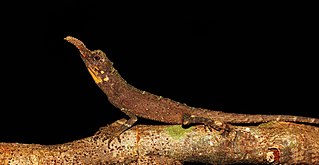
The rough-nosed horned lizard or Sri Lanka horned agama is an Agamid lizard from Sri Lanka in lowland dipterocarp forests and secondary forests in the wet zone. It is distinguished from all the other Ceratophora species by the presence of a complex rostral appendage, comprising more scales than rostral scale alone. The lateral body scales are small and more or less regular shape.
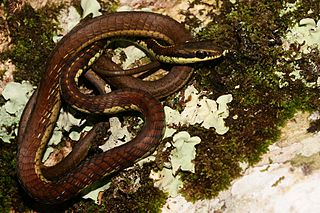
Dendrelaphis schokari, also known as the common bronze-back or Schokar's bronzeback, is a species of non-venomous arboreal snake in the family Colubridae. The species is endemic to Sri Lanka.
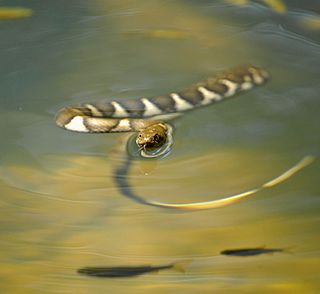
Boulenger's keelback, also known commonly as the Sri Lankan keelback, is a species of water snake in the family Colubridae. The species is endemic to Sri Lanka.

Kaludiya Pokuna Archeological Forest Site is a forest with archeological remains in Kandalama, in the Dry Zone of Sri Lanka. The site has been handed over to the Girls' High School, Kandy in accordance with the "Urumaya Thani Nokaramu" program organized by the Department of Archeology. For the first time in Sri Lanka, a school was given custody of an archeological site.

Aspidura is a genus of snakes in the subfamily Natricinae of the Family Colubridae. The genus is endemic to island of Sri Lanka. Member species are commonly known as rough-sided snakes, except for A. ceylonensis, which is commonly known as the black-spined snake and was formerly in the genus Haplocercus. The genus Aspidura comprises nine species, with the latest having been discovered in 2019.
Rhabdophis ceylonensis is endemic to the island of Sri Lanka. The species is commonly known as the Sri Lanka blossom krait, the Sri Lanka keelback, and මල් කරවලා or නිහලුවා (nihaluwa) in Sinhala. It is a moderately venomous snake.
Aspidura brachyorrhos, commonly known as Boie's rough-sided snake and as ලේ මැඩිල්ලා in Sinhala, is a species of colubrid endemic to Sri Lanka. Bites from this species are known to cause mild local reactions, including a slight burning sensation and swelling.
Aspidura copei, commonly known as Cope's rough-sided snake or කලු මැඩිල්ලා in Sinhalese, is a species of snake in the family Colubridae. The species is endemic to Sri Lanka.
Aspidura deraniyagalae, commonly known as Deraniyagala's rough-sided snake, the Sri Lanka rough-sided snake, and කදු මැඩිල්ලා in Sinhala, is a colubrid species endemic to Sri Lanka.
Aspidura drummondhayi, commonly known as Drummond-Hay's rough-sided snake or කෙටිවල් මැඩිල්ලා in Sinhala, is a species of snake in the family Colubridae. The species is endemic to Sri Lanka.
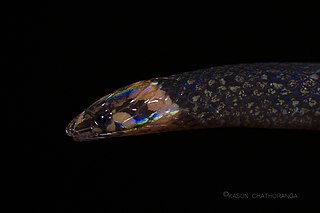
Aspidura guentheri, commonly known as Günther's rough-sided snake, is a species of snake in the family Colubridae. The species is endemic to Sri Lanka. It is the smallest member of the genus Aspidura.

Aspidura trachyprocta, the common rough-sided snake, known as දලව මැඩිල්ලා in Sinhala, is a colubrid species endemic to Sri Lanka.
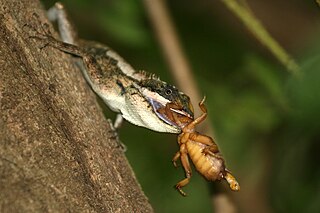
Calotes ceylonensis, commonly known as the painted-lipped lizard or the Ceylon bloodsucker, is a species of lizard in the family Agamidae. It is one of four Calotes species endemic to Sri Lanka.
Smith's snake skink, also known as the two-legged nessia, is a species of skink endemic to island of Sri Lanka.
Nessia burtonii, commonly known as Burton's nessia, Gray's snake skink, or the three-toed snakeskink, is a species of skink, a lizard in the family Scincidae. The species is endemic to the island of Sri Lanka.
Dendrelaphis oliveri, commonly known as Oliver's bronzeback, is a species of nonvenomous arboreal snake in the family Colubridae. The species is endemic to Sri Lanka. It is considered to be the rarest of the Sri Lankan Dendrelaphis species on account of there being only a single recorded specimen.
